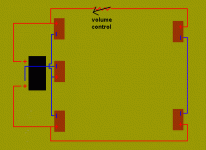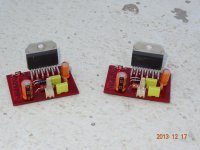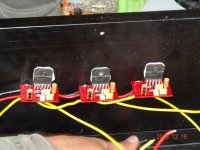An externally hosted image should be here but it was not working when we last tested it.
Apexaudio,
Nice pcb! Even nicer being on a single side (I haven't quite cracked etching my own double sided boards yet)
Can I ask what the gain is in this circuit?
Also, is this your own design or is it based on the Lm3886 reference circuit on the datasheet?
It looks similar,and also simple (which is why i like it ��
Nice pcb! Even nicer being on a single side (I haven't quite cracked etching my own double sided boards yet)
Can I ask what the gain is in this circuit?
Also, is this your own design or is it based on the Lm3886 reference circuit on the datasheet?
It looks similar,and also simple (which is why i like it ��
my 2channel LM3886 chip amplifier
Great work! Congrats Shravanth!
It's a pity we can't find good amp cabinet in India easily.
Nice work,my 2channel LM3886 chip amplifier
Regards
You can use PSU with protect made for AX11Apex can you provide a simple transistor DC detect circuit for use with this LM3886 amp? I am planning to make a compact board with LM3886 and DC detect on it.
Regards
Any issues with bridging negative outputs to add a third center channel?
Hi all, I hope this is not off topic here. I have built and used for some time a stereo amp with LM3886 chip. I m using 8ohm full range speakers and wanted to add a third center channel (also 8ohm) to enhance dialogue when watching movies (hafler mode). This can be done by shorting the output negatives into the return of the third speaker and then connecting the positive of the third speaker into the returns of left and right speakers (summed output). I guess this effectively translates in bridging the amp.
I was wondering if this pose a risk with the LM3886 because of the reduced impedance or if this can be easily handled. Also anyone can tell me what would be in this the actual load that the amp would see?
thank you for your insights!
Hi all, I hope this is not off topic here. I have built and used for some time a stereo amp with LM3886 chip. I m using 8ohm full range speakers and wanted to add a third center channel (also 8ohm) to enhance dialogue when watching movies (hafler mode). This can be done by shorting the output negatives into the return of the third speaker and then connecting the positive of the third speaker into the returns of left and right speakers (summed output). I guess this effectively translates in bridging the amp.
I was wondering if this pose a risk with the LM3886 because of the reduced impedance or if this can be easily handled. Also anyone can tell me what would be in this the actual load that the amp would see?
thank you for your insights!
Searched google and found this:
The proper way is to connect a speaker from the positive on one channel to the positive on the other...that sends any out of phase material to this new speaker. David Hafler (of Dynaco fame) made fooling around with this popular in the early 70's as an alternative to the quadrophonic wars, and it kinda took on the name 'The Hafler Effect', the idea that the only time current flows through the third speaker is when there is a difference between what's playing in the right channel and what's playing in the left.
From some website.
Quote:
A stereo recording actually contains more information than is presented in the left and right channels. All stereo effects are created by a difference in the left and right channels, (ie. providing each ear with a different sound) which immediately creates a new signal; the difference signal. This signal is "decoded" by subtracting one channel from the other. Because stereo effects are created by a difference in the two channels, this signal will contain only the stereo effects. If this difference signal is used to drive a pair of speakers which are placed behind the listener, considerable depth is added to the stereo effects in the recording.
The simple way is to connect a speaker as I mentioned, but some amps won't be too happy about it. Stick to 8 ohm or more speakers (or put two speakers in series to make the load less difficult for the amp) if you want to try this, and no room-shaking volumes.
Edit: If you use two speakers for this effect (which is what Mr. Hafler intended), then they should be wired out-of-phase, such as pos-neg-neg-pos in series between the L and R positive terminals to achieve the full intended effect. And again, two speakers in series is a lot safer for the amp.
__________________
I dont see why you couldnt try this as written above.
CHeck out the link http://music.hyperreal.org/artists/brian_eno/onland-txt.html
The proper way is to connect a speaker from the positive on one channel to the positive on the other...that sends any out of phase material to this new speaker. David Hafler (of Dynaco fame) made fooling around with this popular in the early 70's as an alternative to the quadrophonic wars, and it kinda took on the name 'The Hafler Effect', the idea that the only time current flows through the third speaker is when there is a difference between what's playing in the right channel and what's playing in the left.
From some website.
Quote:
A stereo recording actually contains more information than is presented in the left and right channels. All stereo effects are created by a difference in the left and right channels, (ie. providing each ear with a different sound) which immediately creates a new signal; the difference signal. This signal is "decoded" by subtracting one channel from the other. Because stereo effects are created by a difference in the two channels, this signal will contain only the stereo effects. If this difference signal is used to drive a pair of speakers which are placed behind the listener, considerable depth is added to the stereo effects in the recording.
The simple way is to connect a speaker as I mentioned, but some amps won't be too happy about it. Stick to 8 ohm or more speakers (or put two speakers in series to make the load less difficult for the amp) if you want to try this, and no room-shaking volumes.
Edit: If you use two speakers for this effect (which is what Mr. Hafler intended), then they should be wired out-of-phase, such as pos-neg-neg-pos in series between the L and R positive terminals to achieve the full intended effect. And again, two speakers in series is a lot safer for the amp.
__________________
I dont see why you couldnt try this as written above.
CHeck out the link http://music.hyperreal.org/artists/brian_eno/onland-txt.html
Last edited:
Thanks for the info udaley, I am aware of the hafler matrix and surround effect by adding the "differential signal" to rear speakers wired in series out of phase. What I was trying to accomplish was to add a center channel that narrows the field for dialogue when watching movies. I have seen this accomplished by a summed left and right signal into the third center channel speaker in the way it was described in the schematic that I have attached. It is a sort of an extension to the hafler matrix. I know it works, what I do not know is if the LM3886 amp tolerates shorting the negative outs or what the impact is in terms of load for the amp.
I know it works, what I do not know is if the LM3886 amp tolerates shorting the negative outs or what the impact is in terms of load for the amp.
The way You have drawn that diagram, it won't work.
You have both terminals of the speaker connected to the (common?) ground. There will be nothing more than silence.
You need to put the center speaker between the positive of each amplifier.
Best regards
Ebbe
Last edited:
Thanks for the info udaley, I am aware of the hafler matrix and surround effect by adding the "differential signal" to rear speakers wired in series out of phase. What I was trying to accomplish was to add a center channel that narrows the field for dialogue when watching movies. I have seen this accomplished by a summed left and right signal into the third center channel speaker in the way it was described in the schematic that I have attached. It is a sort of an extension to the hafler matrix. I know it works, what I do not know is if the LM3886 amp tolerates shorting the negative outs or what the impact is in terms of load for the amp.
So you would need to sum the left and right input signals and use the sum as the input to another amplifier.
- Home
- Amplifiers
- Chip Amps
- LM3886 Schematics + PCB


